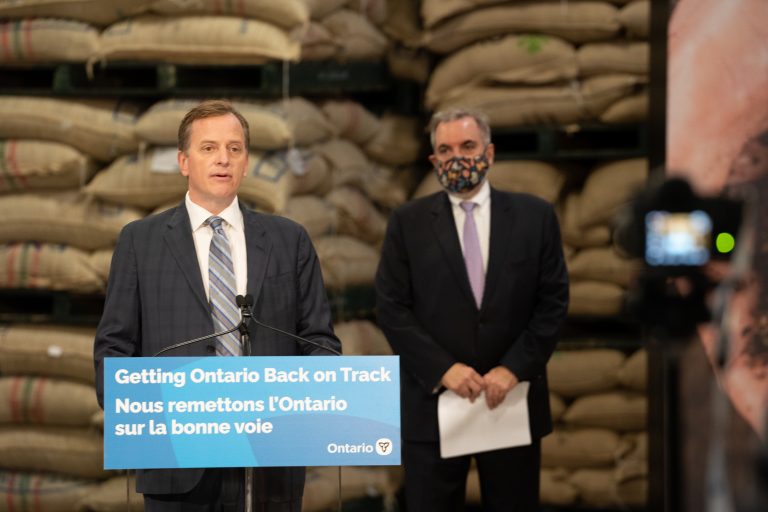What happens to your plastic coffee pods once they’re thrown away? They’re probably going straight to a landfill — even the ones labelled “recyclable”.
Professor Calvin Lakhan of the Faculty of Environmental Studies at Toronto’s York University is one of Canada’s leading experts on our waste systems. His new study, Compostable vs. Plastic Coffee Pods: Separating Fact from Fiction, investigates the real world of the plastic coffee pods found in kitchens and workplaces across the country.

Professor Lakhan knows that Canada is already facing a recycling crisis. China, the Philippines, and other Asian countries are rejecting the plastic waste we used to ship all the way across the Pacific for processing — including small items like plastic coffee pods. As a result, it’s estimated that more than 1.5 billion plastic coffee pods end up in domestic landfills every year, adding to Canada’s single-use plastics crisis.
Professor Lakhan and other experts have identified at least five gaps between what many of us think about plastic coffee pods and what happens in real life. Many of these experts know you have better options for your home coffee brewer.
QUESTIONS ARE BEING ASKED ABOUT THE CHEMICALS IN PLASTIC COFFEE PODS.
Traditional plastic coffee pods are made from polystyrene or polypropylene, can have ethylene-vinyl additives, and can be reinforced with talc to help keep their shape under the pressure of boiling hot water. Some plastic pods have been found to contain bisphenol F (BPF) and bisphenol S (BPS) — two chemicals known to be endocrine disruptors linked to hormone imbalances, weight gain, and fertility issues. Even traditional pods marked “BPA-free” tested positive for estrogenic activity according to a 2011 study by Environmental Health Perspectives.
PLASTIC AND ALUMINIUM COFFEE PODS HAVE AN ENVIRONMENTAL IMPACT.
Aluminum and plastic pods are extremely energy-intensive to manufacture, especially compared to the certified compostable pods designed to break down in municipal composting.
ONCE USED, COMPOSTABLE COFFEE PODS ARE A BETTER OPTION COMPARED TO PLASTIC ONES.
Professor Lakhan estimates that more than 70 percent of all Canadian households have access to some sort of municipal food waste collection or Green Bin program. Certified compostable coffee pods have been designed to break down in those processes, helping create compost that is good for the soil.
CANADIANS WANT TO HELP OUR ENVIRONMENT BY CUTTING SINGLE-USE PLASTIC PACKAGING.
Canadians are united on this. According to one recent survey, 94 percent of Canadians said they were personally motivated to make changes around plastic use. Residents of Nova Scotia and Quebec were the most enthusiastic about modifying their behaviour for the health of the environment.
RECYCLERS PROBABLY DON’T WANT YOUR PLASTIC COFFEE PODS.
Professor Lakhan says that very few recycling operations want plastic coffee pods, no matter what the label on a package says — and even if you follow all the steps on the package. Facilities often don’t have the ability to recycle plastic pods because they’re too light for automated sorting. They’re commonly rejected and sent to landfills.

Feel Good About Your Morning Cup of Coffee with Compostable Pods
Canadians love their coffee. Our adults drink more coffee than even tap water. But what don’t Canadians love? Plastic, especially when it harms the environment and raises health questions.
Fortunately, Canadians have a choice. Club Coffee offers consumers PurPod100TM — the world’s first certified 100 percent compostable pod. Created in conjunction with scientists at the University of Guelph, the technology was first brought to market in the fall 2015.

“The amount of used traditional plastic coffee pods sent into the waste stream over the years could circle the earth over 11 times. That’s not acceptable,” says John Pigott, CEO of Club Coffee. “We have the most viable solution to that issue.”
Every part of the PurPod100TM was designed to reduce food waste. Lids are made with paper and other compostable materials and inks. The ring that holds the pod in a brewer is made with plant-based renewable materials. More than 20 percent of that ring is coffee chaff, the thin outer layer or husk of the coffee bean. Putting all those organic elements together with delicious coffee makes it especially appealing to the microorganisms that make composting happen after you’ve enjoyed your cup of delicious coffee.
Speaking of taste, how do you like your coffee? With a bit of sugar, cream, or milk, and a hint of plastic? Coffee lovers report that choosing coffee with a compostable pod delivers better taste.
When you think about the big picture on single-use coffee pods, you have a clear choice. Traditional plastic pods will probably be buried in landfills, long after you’ve brewed your morning cup. Switching to compostable single-use coffee pods is something we can feel good about. They deliver great taste today and keep plastic and chemicals of concern out of our environment forever.
YouTube Video: Media Planet Video by: YAP

Article Credit goes to: Michele Sponagle and Mediaplanet Canada
To see the original article please visit: https://bit.ly/2nciS48




